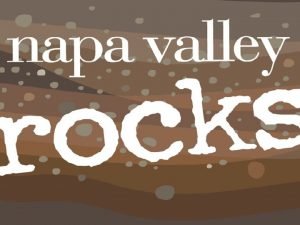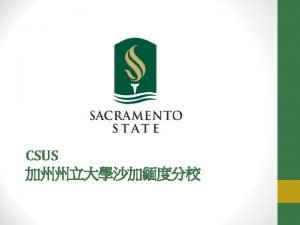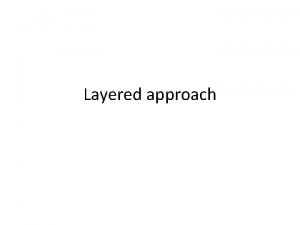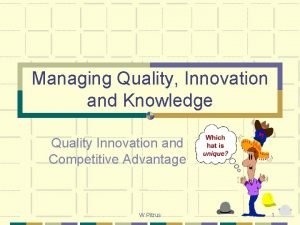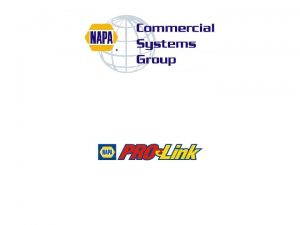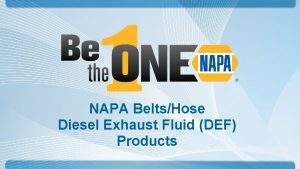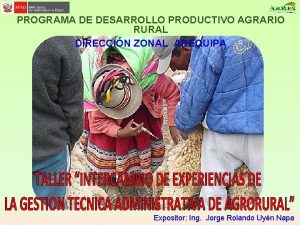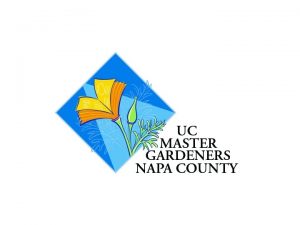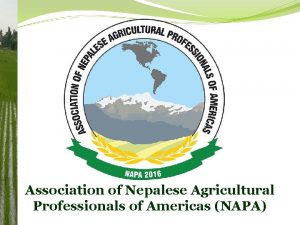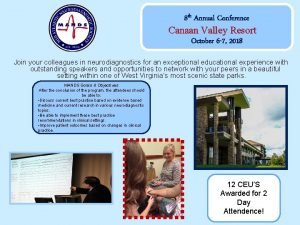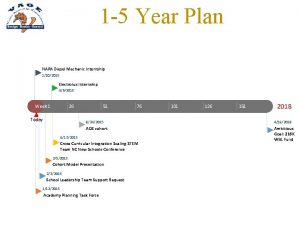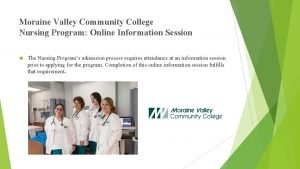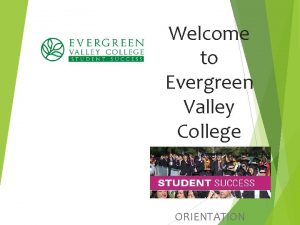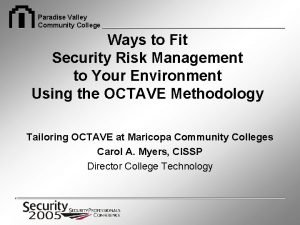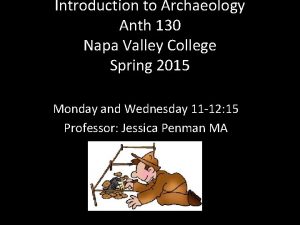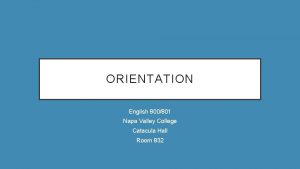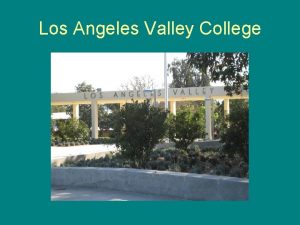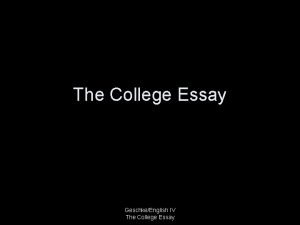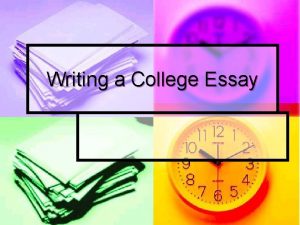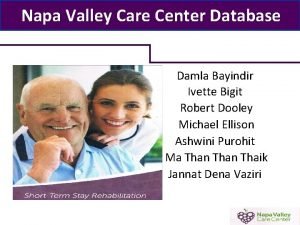Napa Valley College and the Quality Focus Essay


















- Slides: 18

Napa Valley College and the Quality Focus Essay CHALLENGES, STRATEGIES, AND LESSONS LEARNED Erik Shearer, Professor of Art, Accreditation Faculty Co-chair Dr. Robyn Wornall, Dean of Research, Planning and Institutional Effectiveness Napa Valley College

Background • NVC requested permission to use the new standards. (Yes, we really asked to do this!) • Good history of positive evaluations and relationship with Commission. • History of campus-wide participation in past self-evaluation processes. • Co-chairs that like a challenge!

I. Challenges

QFE Challenges • Unfamiliarity with new component of self-evaluation process. (ACCJC was developing materials as NVC was writing report and QFE. ) • Underestimated role / timing of QFE in overall evaluation process. • Process for determining projects / planning. • Ensuring that QFE was clearly derived from SER. Differing opinions on function of the QFE! • Campus participation and buy-in.

II. Strategies

Strategies to Address Challenges • Developed topics and direction for QFE from analysis of evaluation and action plan components of SER to ensure that QFE was aligned with findings in the self-evaluation. • Held campus-wide forums dedicated to the QFE, and informed campus community of 3 areas of focus as they emerged from drafts of SER. • Worked with Steering Committee (President’s Cabinet and constituent group leadership) to identify plans and personnel going forward. • Worked to integrate plans from QFE into existing college plans, structures, and committees.

Sample Spreadsheet Used to Identify Areas of Focus for QFE Standard # Standard Language Status Eval I. B. 02 The institution defines and assesses student learning outcomes for all instructional programs and student and learning support services. I. B. 04 The institution uses assessment data and organizes its institutional processes to support student learning and student achievement. I. B. 06 The institution disaggregates and analyzes learning outcomes and achievement for subpopulations of students. When the Meets, needs institution identifies performance gaps, it implements strategies, which may include allocation or reallocation of Improvement human, fiscal and other resources, to mitigate those gaps and evaluates the efficacy of those strategies. I. B. 07 The institution regularly evaluates its policies and practices across all areas of the institution, including instructional programs, student and learning support services, resource management, and governance processes to assure their effectiveness in supporting academic quality and accomplishment of mission. Meets, needs improvement Meets, needs Improvement Category for QFE Specific areas for improvement Assessment While NVC has defined SLOs for all courses, instructional programs, and student learning and support services, assessment is not an ongoing, systemic process across the entire institution. In some cases, no sustained, substantive assessment work has been completed at the program or course level in Instructional programs. There are pockets of good, ongoing practice, but these are the exception. Assessment The area for improvement is tied to the problems noted under I. B. 2: we don't have enough assessment data to fully support that we use it to organize institutional processes to support student learning and achievement. We meet the standard, but at a very basic level and primarily in structure and theory, not in evidenced practice. Assessment data is not currently collected or tracked at the level of individual students, which would allow for full disaggregation of assessment data by subpopulations of students. Disaggregations in current use provide good information, but not the same level of detail provided in disaggregation of student achievement data. We can improve with regard to "regularly evaluates…policies and Regular Evaluation practices…[in] governance. " Our policies and practices are evaluated, of Institutional but not regularly or in regards to their effectiveness in "…supporting Effectiveness academic quality and accomplishment of mission. "

Results of Analysis of SER for QFE Three areas for improvement: o Student Learning Assessment o Integration of Planning & Resource Allocation o Institutional Effectiveness, Evaluation & Review 6 priority areas for targeted improvement identified in SER o All 6 of these Standards were associated with 3 components of QFE o Highlighted in evaluation portions of SER (“meets the Standard at a basic level”; “needs to build on effective practices to strengthen use and consistency”) SER included action plans associated with an additional 36 Standards o Majority (78%) of those Standards were related to 3 areas for improvement outlined in QFE (19%, 33%, and 25%, respectively) (p. 329 of NVC SER)

III. The Product

Structure of QFE Four sections of the QFE: 1. Overview and Background o How APs were identified o Purpose/Objective of each AP o Philosophy/Approach toward APs/QFE 2. Findings from Self-Evaluation o Issues identified o Solutions to explore o Description of recent improvements and effective practices

Structure of QFE 3. Conceptual/Vision Maps Outlining Action Projects o Describe what SL assessment and regular evaluation and review will “look like” once changes are implemented o Intended as a starting point for the QFE Teams 4. Timelines, Observable Outcomes, & Structures to Monitor Progress o General description of timeline and outcomes o Proposed structure for QFE Teams Action Project General o o o Phase 1: Clarification of Expectations & Evaluation of Practices 2015 -2016 through Fall 2016 Expand conceptual/vision maps to include more detail Clarify roles and expectations for three Action Projects Identify solutions/what needs to be done to implement the vision Phase 2: Implementation of Solutions Spring 2017 through 2017 -2018 o Implement improvements/ solutions to approach the vision outlined in the conceptual maps o Evaluate as changes are implemented o o Phase 3: Integration & Expansion of Practices 2018 -2019 through Fall 2019 Expand effective practices Strengthen integration between three components of Action Project

Student Learning Assessment AP Purpose/Objective: To increase the effectiveness of the institution in using student learning assessment data to inform dialogue at all levels, increase student learning and achievement, and ensure accomplishment of mission o o o Phase 1: Clarification of Expectations & Evaluation of Practices 2015 -2016 through Fall 2016 Update 5+1 Assessment Cycle, define expectations for “ongoing assessment” Explore mechanisms for collecting student -level data (uniform, centralized collection) Pilot data collection to develop sample reports Integrate Inquiry Groups/ILO assessment into existing structures Develop central repository to share effective practices and results Implement PLO template across instructional programs o o o Phase 2: Implementation of Solutions Spring 2017 through 2017 -2018 Develop/Update assessment plans at all levels (according to new cycle and new structure) Implement data collection across programs and services Disaggregate data by course characteristics and subpopulations of students Provide regular opportunities for discussion of SL, SB, and SA Communicate results of assessment at all levels to a variety of audiences o o Phase 3: Integration & Expansion of Practices 2018 -2019 through Fall 2019 Discussions of SL, SB, and SA directed at improving SL and SA Strengthen integration with planning and resource allocation

Vision Map for Student Learning Assessment

Institutional Effectiveness, Evaluation, and Review AP Purpose/Objective: To increase the effectiveness of the institution in conducting regular evaluations of organizational structures and practices, communicating the results of those evaluations, and implementing changes in a timely manner to support student achievement, student learning, and accomplishment of mission o o Phase 1: Clarification of Expectations & Evaluation of Practices 2015 -2016 through Fall 2016 Clarify roles, responsibilities, and processes Focus on effectiveness and results Expand complete Decision-Making Guide, including roles of committees in accreditation Develop effective methods for communicating purpose of evaluation activities, anticipated outcomes, and results of evaluation o o o Phase 2: Implementation of Solutions Spring 2017 through 2017 -2018 Apply evaluation cycle to institutional review and evaluation processes Review Decision-Making Guide (ongoing) and refine to clarify practices, processes, policies as changes are implemented Implement effective communication methods o o Phase 3: Integration & Expansion of Practices 2018 -2019 through Fall 2019 Evaluate effectiveness of improvements implemented Expand evaluation and communication mechanisms to other areas, as appropriate

Vision Map for Regular Evaluation

IV. Lessons Learned

Lessons Learned • QFE was a much larger component of the SER process than it appeared at first. • “Cooling off” time between SER and QFE would have been beneficial. • Involve as many people as possible in developing themes and projects for QFE. Buy-in for the analysis is crucial for institutionalization. • Use existing committees and processes to integrate results of QFE into institutional structures. • Interesting balance between forward-looking, positive approach and wanting to “fix” all of the problems made evident in the selfevaluation process.

Questions? Thank you!
 Los angeles napa valley
Los angeles napa valley Lake tahoe to napa valley
Lake tahoe to napa valley Cost focus and differentiation focus
Cost focus and differentiation focus Differentiation cost leadership
Differentiation cost leadership Prolepsis
Prolepsis Actor focus vs object focus
Actor focus vs object focus Process methods and tools
Process methods and tools Focus quality innovation
Focus quality innovation Napa prolink support
Napa prolink support Napa def fluid
Napa def fluid Napa integrated business solutions
Napa integrated business solutions Jorge rolando uyen napa
Jorge rolando uyen napa Tree of 40 fruits
Tree of 40 fruits Napa nepal
Napa nepal Neurodiagnostics near graton
Neurodiagnostics near graton Napa dietetic internship
Napa dietetic internship Moraine valley admissions
Moraine valley admissions Evergreen valley college summer classes
Evergreen valley college summer classes Hotels near paradise valley community college
Hotels near paradise valley community college
